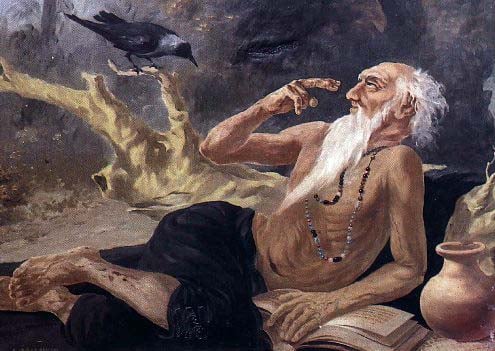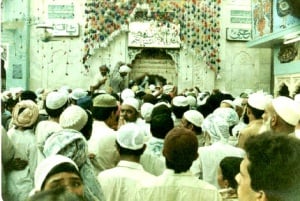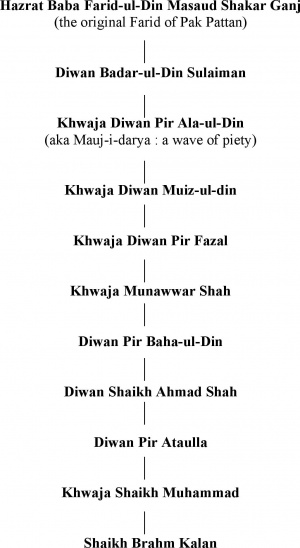Sheikh Farid: Difference between revisions
(Pasted link to Prof sahib Singh's Darpan) |
(Pasted link to the gurbani title of the Image) |
||
| Line 2: | Line 2: | ||
[[Image:Babafarid quote 1.jpg|500px|right|]] | [[Image:Babafarid quote 1.jpg|500px|right|]] | ||
http://www.gurugranthdarpan.com/1382.html | |||
http://www.sikhseek.com/cgi-bin/links/jump.pl?ID=2202 | http://www.sikhseek.com/cgi-bin/links/jump.pl?ID=2202 | ||
Revision as of 18:08, 2 October 2005
http://www.gurugranthdarpan.com/1382.html
http://www.sikhseek.com/cgi-bin/links/jump.pl?ID=2202
There are 134 hymns of Farid incorporated in the Guru Granth Sahib. Many Sikh scholars ascribe them to Farid Shakarganj (1173 – 1265) of Pak Pattan, a disciple of the Sufi Qutbuddin Bakhtiyar Kaki. The tenth in succession to his post was Shaikh Brahm (Ibrahim), also known as Farid Sani or Farid the 2nd, and it is this Farid who Guru Nanak Dev ji met on two occasions.
Macualiffe states that hymns ascribed to Farid are compositions by the lattar, whereas others ascribe them to Farid Shakarganj. There are others who believe that the hymns were composed by different Sufis of the Pak Pattan centre, all using the poetic name Farid.
As a result, no account would be complete without details of both of the Farid’s lives.
Shaikh Farid (1173-1265 A.D)
There is a great deal known or written regarding the original Shaikh Farid. Two genealogies of Shaikh Farid, subsequently called Farid Shakar Ganj, are given in the Jawahir-i-Faridi – one spiritual, the other temporal. He received his spiritual position from his priest Khwaja Qutub-ul-din Bakhtiyar Ushi of Dihli, whose spiritual predecessors ascend in a direct line to the Prophet of Makka. Farid’s temporal or family genealogy is traced back through princes and kings to Hazrat Amir-ul-Mumanin Umr-bin-ul Khitab Qureshi Makki Faruqi, the second Khalifa of the Muhammadans.
Nizam-ul-Din Auliya, a disciple of Farid, relates a legend of a robber who went to Farid’s mother’s house to steal. On beginning his operations he lost his sight. He then cried out that there must be some saint or miracle-worker present. He vowed that, if his sight was restored, he would renounce thieving and become a good Muhammadan. On hearing his vow Miriam prayed for him, and his sight was restored. He went home, and returned to her the following morning with an offering of milk. Accompanied by his wife and children, he expressed a desire that they should all become Muhammadans. Miriam caused his wishes in this respect to be gratified, with the result that thay all became holy. In reply to her, he said his name was Chawa. His shrine among others in that locality subsequently became a place of devout pilgrimage.
When Farid was conceived, his mother used to spend her days and nights in prayer. He was born at Kothiwal on the first day of the month of Ramzan, A.H. 569 (A.D. 1173). The night of his birth was dark and cloudy, and the moon, whose appearance indicates the beginning of Ramzan – the Muhammadan lent – could not be seen, so med did not know when to begin their fast. A holy man arrived and said that a wonderful son had been born to Jamal-ul-Sulaiman. If the infact suckled, the time for fasting had not yet begun, but if, on the contrary he refused the breast, then all good Muhammadans must fast. Farid did not suckle, and so it was apparent the fast had begun. During the whole month of Ramzan, it is said, the infant only took milk by night in the Muhammadan fashion and fasted by day.
Shakar Ganj
When Farid was a few years old his mother taught him his prayers. The boy asked what was gained by his prayes. His mother replied 'sugar'. She used to accordingly hide some sugar under his prayer-carpet, and, when he had finished his prayers, draw it forth, and give it as a reward for his devotion. One one occasion, when his mother was absent, he prayed a great deal, and, it is said, a great supply of sugar - a miraculous gift from God - was found under his carpet. Some he ate himself and the rest he gave to his playfellows. He related the circumstance to his mother on her return. It was then his mother gave him the surname Shakar Ganj, meaning a treasury of sugar.
Shaikh Brahm ( -1552 A.D)
Shaikh Brahm holds a distinguished place in the list of great saints, and bears several titles or appellations. He is called Farid Sani or Farid the Second, Salis Farid or the arbitrator Farid, Shaikh Brahm Kalan (Shaikh Brahm the elder), Bal Raja, Sahikh Brahm Sahib, and Shah Brahm.
He is said to have performed many miracles. The following is given as an example. A thief once entered his house with criminal intent, but by God’s will was struck blind and could not find his way out. When Shaikh Brahm arose at night to pray, he told his servant to fetch water for his abdulations. The servant saw the blind thief standing helpless on the floor, and informed his master. The thief prayed for forgiveness, and promised that, if he recovered his sight, he would renounce his evil ways. Upon this Shaikh Brahm prayed for him; he recovered his sight, and became a devout Musalman. Another of Shaikh Brahm’s miracles is this: In a season of drought he took off his turban and began to whirl it about, upon which rain fell abundantly.
Two sons of Shaikh Brahm are mentioned – one Shaikh Taj-ul-Din Mahmud, a great saint, and another Shaikh Munawwar Shah Shahid. Shaikh Brahm had several disciples, such as Shaikh Salim Chishti Fatahpuri, Shaikh Ahmadi of Chunian, Baba Ahmad Lanak of Dipalpur, Maulvi Jalal-ul-Din of Shaikhbad, Shah Abdul Fatah of Ghazipur, Haji Niamat Ulla of Shaikhupur &c.
Shaikh Brahm died on the 21st of Rajab, A.H. 960 (A.D 1552), after a spiritual reign of 42 years. The Kaulasat-ul-Tawarikh states that he was buried at Sarhind.
Farid's Bani
Bhagat Farid Ji’s Bani from page 488 of SGGS: External Link to Bani
- They alone are true, whose love for God is deep and heart-felt. Those who have one thing in their heart, and something else in their mouth, are judged to be false. ||1|| Those who are imbued with love for the Lord, are delighted by His Vision. Those who forget the Naam, the Name of the Lord, are a burden on the earth. ||1||Pause|| Those whom the Lord attaches to the hem of His robe, are the true dervishes at His Door. Blessed are the mothers who gave birth to them, and fruitful is their coming into the world. ||2|| O Lord, Sustainer and Cherisher, You are infinite, unfathomable and endless. Those who recognize the True Lord - I kiss their feet. ||3|| I seek Your Protection - You are the Forgiving Lord. Please, bless Shaykh Fareed with the bounty of Your meditative worship. ||4||1||
Page 1377 of SGGS: External Link to Bani
- The day of the bride’s wedding is pre-ordained. On that day, the Messenger of Death, of whom she had only heard, comes and shows its face. It breaks the bones of the body and pulls the helpless soul out. That pre-ordained time of marriage cannot be avoided. Explain this to your soul. The soul is the bride, and death is the groom. He will marry her and take her away. After the body sends her away with its own hands, whose neck will it embrace? The bridge to hell is narrower than a hair; haven’t you heard of it with your ears? Fareed, the call has come; be careful now - don’t let you be robbed. ||1||
External Links
References
- Macauliffe, M.A (1909). The Sikh Religion: Its Gurus Sacred Writings and Authors. Low Price Publications. ISBN 8175361328.
- Singh, Khushwant (1963). A History of the Sikhs: 1469-1839 Vol.1 (2nd ed.). Oxford University Press. ISBN 0195673085.




